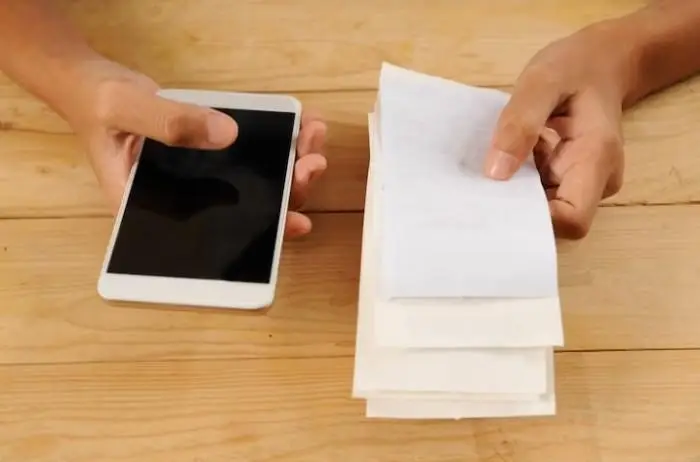Thermal paper is designed to change color when a certain temperature is brought to it. It all happens thanks to the heat-sensitive coating that reacts when introducing heat. These days, it has massively taken over almost all the industrial sectors in the world and doesn’t seem to stop.
So, how can you distinguish it from regular thermal paper? In this guest post, we will discuss identifying whether or not the receipt you are holding came from thermal paper.
The Three Simple Tests
- The Scratch Test
It is one of the easiest ways to identify whether or not the paper that came out of thermal paper rolls is a thermal receipt. The paper has a special coating of heat-sensitive substance that tends to react with heat and changes color.
Also, when you try scratching on the surface of the paper, due to friction, it generates heat, and the paper turns black.
Therefore, it leaves a mark on the surface, and through this way, you can easily identify whether or not it is a legit audit paper that came out of the roll.
- Smooth and Buttery Surface
It is another way to prove the legitimacy of the paper. As mentioned above, the paper roll has a special coating that makes you feel like a waxed surface.
The buttery smooth surface is the coated layer of chemicals that help print images on the paper when the temperature rises.
However, in some cases, even bond paper has the same waxed-like surface. Therefore, other than this, there are more legitimate ways to identify thermal paper receipts.
- Testing on Thermal Printer
It is one of the best ways to prove the legitimacy of a receipt paper. Thermal printers use a print head that produces heat when the receipt roll is placed in the device.
If you put any paper other than thermal paper, it won’t produce any results. Only a receipt paper with the right amount of heat-sensitive material can do the same.
If the printer produces printed images, you can safely say it’s the thermal receipt you were testing.
Important Factors to Consider While Selecting a Good Quality Thermal Paper
As you already know, receipt paper is a thermal receipt that requires a specific printer for printing on the paper. Its quality affects the overall performance of the business directly. The effectiveness of business performance is directly proportional to the print quality of the paper.
The quality of the receipt paper also affects the service life of the equipment, like direct thermal printers and thermal transfer ones. The market currently has good-quality thermal paper rolls and not-so-good quality receipt rolls.
Also, due to the lack of necessary guidelines that can separate a quality paper roll from inferior quality, it’s hard to know which roll is good quality and which is not.
Fortunately, we made it easy for you. Check it out;
- The Roll Size
The roll size of thermal paper plays an important role in distinguishing whether or not the receipt paper is of good quality. Even though the market is available with rolls with different lengths and widths, just because you opt to go with a thicker roll doesn’t mean it’s appropriate for you.
The thinner the paper is, the more printed receipts it will produce. The longer a roll will create the printed images, the more economical it will be for your business. Therefore, next time you go to the market to purchase a good quality roll, you must consider this factor.
- Experienced Dealer
Many dealers are offering their services to optimize your business with the help of high-quality thermal paper rolls, but not all will live up to your expectations. Fortunately, Telemark Diversified Graphics will provide you with thin quality rolls (thus, last long) and provide insight into their services by providing you with a sample of their products if you ask them.
Their high-performance receipt rolls are specifically designed with industrial-grade materials that offer long-lasting printed receipts. The printed text and images last for several months to several years. They provide bulk pricing and cost-effective thermal paper products to businesses all across the US.
- BPA in thermal paper
BPA is one of the chemicals used in fabricating a receipt roll. However, due to rising environmental concerns, many customers demand BPA-free paper. TDG is one of the first few distributors in the US that came up with environment-friendly thermal papers.
Their Alpha-free Vitamin C-treated POS rolls are extremely safe for the fauna and flora and offer a distinctive pale-yellow look that separates their paper from a chemically treated paper roll. Also, the color combination offers an organic look to the paper.
Additional Quality Identification
The printing paper is usually divided into three important layers.
1. Bottom layer, which is paper-based.
2. The mid layer with a thermal coating.
3. Last one is the protective layer.
- The Fire Test
It is one of the most intuitive and simplest tests you can conduct to prove the legitimacy of the quality of a thermal paper roll. If the paper turns brown when you bring it close to the fire and leaves white fuzzy spots, the heat-sensitive substance is not appropriately incorporated.
Besides that, if the black portion of the paper leaves irregular streaks, the coating is uneven, and the paper is not of good quality.
- Testing Appearance
If the paper is more white than usual, the paper’s third (protective) layer is compromised, and you must look for a better thermal paper roll deal elsewhere. You can also conclude the same by finding out if there is inconsistency in the coating layer.
Bottom Line
Identifying a quality paper is just as necessary as maintaining your business operations. While a not-so-good choice in selecting the high-quality can impact your business negatively, a good-quality thermal paper solution can not only automate your business but also saves you time and money.
Read more: Press Cleaners For the Printing Business
FAQs.
Q. What type of paper is thermal paper?
A. It is composed of a heat-sensitive material that prints images when heat is presented through a heated print head. Although various varieties are available in the market, look for the one that fits your business model.
Q. What is the GSM of thermal paper?
A. In general, the thickness varies from 20 to 150 microns. The GSM varies from 48 to 120.
Q. Where to get quality thermal paper rolls?
A. There are various market players out there offering audit rolls. However, look for the one with extensive expertise, a big supply chain, and great customer experience.




